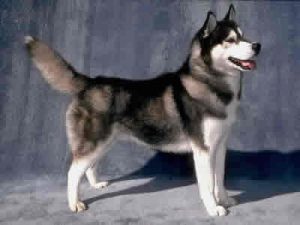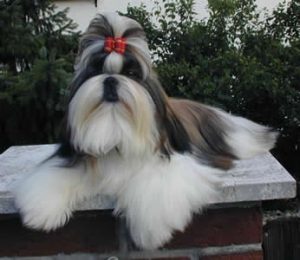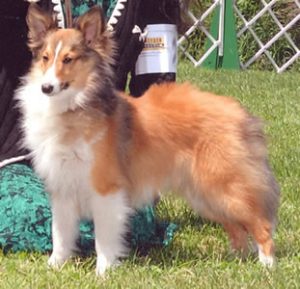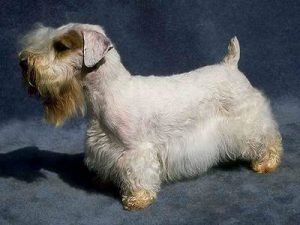
The Siberian Husky is a medium-size, dense-coat working dog breed that originated in eastern Siberia. The breed belongs to the Spitz genetic family. It is recognisable by its thickly furred double coat, sickle tail, erect triangular ears and distinctive markings.
Huskies are an active, energetic and resilient breed whose ancestors came from the extremely cold and harsh environment of the Siberian Arctic. Siberian Huskies were bred by the Chukchi of Northeastern Asia. The dogs were imported into Alaska during the Nome Gold Rush and later spread into the United States and Canada. They were initially sent to Alaska and Canada as sled dogs but rapidly acquired the status of family pets and show-dogs.
Appearance
Siberian Huskies share many outward similarities with the Alaskan Malamute as well as many other Spitz breeds such as the Samoyed, which has a comparable history to the Huskies. They come in a variety of colours and patterns, usually with white paws and legs, facial markings, and tail tip. The most common colours are black and white, copper-red and white, grey and white, and pure white, though many individuals have blondish, or piebald spotting. Striking masks, spectacles, and other facial markings occur in wide variety. They tend to have a wolf-like appearance.
Eyes
The eyes of a Siberian Husky are ice blue, dark blue, amber, or brown. In some individual dogs, one eye may be brown and the other blue (complete heterochromia), or one or both eyes may be “parti-coloured,” that is, half brown and half blue (partial heterochromia). All of these eye colour combinations are considered to be acceptable by the American Kennel Club, which also states that the eyes are “an almond shape, moderately spaced and set slightly obliquely.”
Coat
The Siberian Husky’s coat is thicker than most breeds of dogs, comprising two layers: a dense undercoat and a longer topcoat of short, straight guard hairs. It protects the dogs effectively against harsh Arctic winters, but the coat also reflects heat in the summer. It is able to withstand temperatures as low as −50 °C to −60 °C. The absence of the undercoat is often present during shedding. Their thick coats require weekly grooming Long guard hair is not desirable and is considered a fault.
Nose
In some instances, Siberian Huskies can exhibit what is called “snow nose” or “winter nose”. This condition is called hypopigmentation in animals. Show-quality dogs are preferred to have neither pointed nor square noses in shape. The nose is black in grey, tan in black dogs, liver in copper-coloured dogs, and may be flesh-coloured in white dogs. “Snow nose” is acceptable in the show ring.
Size
The breed standard indicates that the males of the breed are ideally between 21 and 23.5 inches (53 and 60 cm) tall at the withers and weighing between 45 and 60 pounds (20 and 27 kg). Females are smaller, growing to between 20 to 22 inches (51 to 56 cm) tall at the withers and weighing between 35 to 50 pounds (16 to 23 kg).
Behaviour
The Siberian Husky has been described as a behavioural representative of the domestic dog’s forebearer, the wolf, exhibiting a wide range of its ancestors’ behaviour. They are known to howl rather than bark. Hyperactivity displaying as an overactive hunting drive, a characteristic of kennelled dogs, is often noticeable in dogs released from their captive environment for exercise – a behaviour welcome in hunting dogs but not in the family pet. The frequency of kennelled Siberian Huskies, especially for racing purposes, is rather high, as attributed through the history of the breed in North America. They are affectionate with people, but independent. A fifteen-minute daily obedience training class will serve well for Siberian Huskies. Siberian Huskies are a very stubborn and dominant breed of dog. Siberians need consistent training and do well with a “Nothing In Life Is Free” training program. They rank 45th in Stanley Coren’s The Intelligence of Dogs, being of average working/obedience intelligence. They tend to run because they were at first bred to be a sled dog. Owners are advised to exercise caution when letting their Siberian Husky off the leash as the dog is likely to be miles away before looking around and realising their owner is nowhere in sight. They also get bored easily, so playing with toys or throwing the ball at least once a day is essential. Failure to give them the attention or proper exercise they need can result in unwanted behaviour, such as excessive howling, marking, chewing on furniture, or crying.
—————————————————————————————————————–
CARING FOR YOUR DOG NEWSLETTER – Delivered Directly To Your Inbox – Starting Immediately – SIGN UP FOR FREE TODAY
—————————————————————————————————————–




